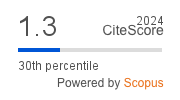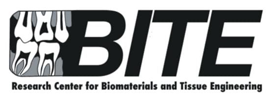Bond strength of a silicon-based soft liner to three types of denture base materials
Downloads
Background: Silicon-based soft liners have poor chemical adhesion to denture base resin, as they depend on mechanical interlocking. De-bonding between denture resin and soft liners is a common problem, as it shortens the life of a relined prosthesis. Purpose: The purpose of the study was to assess the tensile bond strength of three types of denture base materials—fabricated by conventional heat curing, computer-aided design/computer-aided manufacture, and three-dimensional printing, or milling—that are bonded to the silicon-based soft liner. The study also aimed to evaluate the effect of surface treatment (acetone; erbium- and chromium-doped yttrium, scandium, gallium, and garnet [Er,Cr:YSGG] laser) of denture base materials on the bonding capability of the soft liner. Methods: A total of 90 specimens were divided into three groups according to the denture base type (conventional, printed, and milled). The 30 specimens in each group were then subdivided into three sub-groups according to the surface treatment (untreated, acetone, and Er,Cr:YSGG), such that each sub-group included 10 specimens. The denture base was bonded to a ready-to-use paste of the silicon-based soft liner. The strength of the tensile bond was tested using a universal testing machine. Data were statistically analyzed using SPSS v.26 software, two-way ANOVA, and Duncan’s test at a significance level of p ≤ 0.05. Results: The milled denture base showed a higher mean tensile bonding strength compared with the conventional and printed denture base materials, at p ≤ 0.05. The surface treatment with Er,Cr:YSGG and the acetone, respectively, showed a higher mean tensile bonding strength value than the untreated group, at p ≤ 0.05. Conclusion: A milled denture is the most favorable denture base material for bonding to a silicon-based soft liner. The use of Er,Cr:YSGG and acetone surface treatment, respectively, enhances the tensile bonding strength.
Downloads
Prahasanti C, Setijanto D, Ernawati DS, Ridwan RD, Kamadjaja DB, Yuliati A, Meizarini A, Hendrijantini N, Krismariono A, Supandi SK, Saskianti T, Sitalaksmi RM, Kuswanto D, Putri TS, Ramadhani NF, Ari MDA, Nugraha AP. Utilization of polymethyl methacrylate and hydroxyapatite composite as biomaterial candidate for porous trabecular dental implant fixture development: a narrative review. Res J Pharm Technol. 2022; 15(4): 1863–9. doi: https://doi.org/10.52711/0974-360X.2022.00312
Yang H, Sun L, Yu H, Nugraha AP, Vanegas Sáenz JR, Hong G. Current prospect of dental zirconia recycling: A scoping review. J Prosthodont Res. 2024; 68(4): JPR_D_23_00186. doi: https://doi.org/10.2186/jpr.JPR_D_23_00186
Awad AN, Cho S-H, Kesterke MJ, Chen J-H. Comparison of tensile bond strength of denture reline materials on denture bases fabricated with CAD-CAM technology. J Prosthet Dent. 2023; 129(4): 616–22. doi: https://doi.org/10.1016/j.prosdent.2021.06.047
Alharbi N, Wismeijer D, Osman R. Additive manufacturing techniques in prosthodontics: Where do we currently stand? A critical review. Int J Prosthodont. 2017; 30(5): 474–84. doi: https://doi.org/10.11607/ijp.5079
Alshakaki HSA, Al-Essa HA. A comparative evaluation of shear bond strength between self-cured resilient liner and denture base resin with different surface treatments. Int J Appl Dent Sci. 2020; 6(3): 684–7. doi: https://doi.org/10.22271/oral.2020.v6.i3j.1026
Adiana ID, Abidin T, Syafiar L. Color stability of heat polymerized polymethyl methacrylate resin denture base after addition of high molecular nano chitosan. Dent J. 2016; 49(4): 185–8. doi: https://doi.org/10.20473/j.djmkg.v49.i4.p185-188
Kreve S, Dos Reis AC. Denture liners: A systematic review relative to adhesion and mechanical properties. Sci World J. 2019; 2019: 6913080. doi: https://doi.org/10.1155/2019/6913080
Kurdi A, Sunariani J, Rahmania PN. Pain in knife edge edentulous ridge treated with complete denture. Biochem Cell Arch. 2020; 20: 3071–4. doi: https://doi.org/10.35124/bca.2020.20.S1.3071
Nakhaei M, Dashti H, Ahrari F, Vasigh S, Mushtaq S, Shetty RM. Effect of different surface treatments and thermocycling on bond strength of a silicone-based denture liner to a denture base resin. J Contemp Dent Pract. 2016; 17(2): 154–9. doi: https://doi.org/10.5005/jp-journals-10024-1819
Rajaganesh N, Sabarinathan S, Azhagarasan NS, Shankar C, Krishnakumar J, Swathi S. Comparative evaluation of shear bond strength of two different chairside soft liners to heat processed acrylic denture base resin: An in vitro study. J Pharm Bioallied Sci. 2016; 8(Suppl 1): S154–9. doi: https://doi.org/10.4103/0975-7406.191948
Panda S, Reddy N, Manual L, Krishna C, Jagadeesh K, Saidath K, Babaji P. An in vitro evaluation of tensile bond strength of soft liners bonded to different denture base resins. Ann Afr Med. 2021; 20(2): 116. doi: https://doi.org/10.4103/aam.aam_30_20
Özdemir H, Özdoğan A. Bond strength of resilient lining materials to denture base resin: A systematic review and meta‐analysis. J Prosthodont. 2018; 27(9): 828–41. doi: https://doi.org/10.1111/jopr.12958
Cavalcanti YW, Bertolini MM, Del Bel Cury AA, da Silva WJ. The effect of poly(methyl methacrylate) surface treatments on the adhesion of silicone-based resilient denture liners. J Prosthet Dent. 2014; 112(6): 1539–44. doi: https://doi.org/10.1016/j.prosdent.2013.07.031
ASTM. D412 standard test methods for vulcanized rubber and thermoplastic elastomers tension. West Conshohocken, PA: ASTM International; 2021. p. 1–14. web: http://www.astm.org/cgi-bin/resolver.cgi?D412-16R21
Azpiazu Flores FX. The effect of thermocycling on the adhesive strength of three long-term resilient liners to dental polymers used for the additive, subtractive and formative manufacture of complete dentures. The Ohio State University; 2021. p. 1–83. web: http://rave.ohiolink.edu/etdc/view?acc_num=osu162429775869981
Dohiem MM. Comparison of Bond strength between acrylic based soft liner and two different denture bases (3Dprinted and conventional denture base). Egypt Dent J. 2022; 68(1): 659–63. doi: https://doi.org/10.21608/edj.2021.94616.1784
Zeidan AAE-L, Abd Elrahim RA, Abd El Hakim AF, Harby NM, Helal MA. Evaluation of surface properties and elastic modulus of CAD-CAM milled, 3D printed, and compression moulded denture base resins. J Int Soc Prev Community Dent. 2022; 12(6): 630–7. doi: https://doi.org/10.4103/jispcd.JISPCD_158_22
Hafez AMF, Abdelrahim R, Abdel Hameed B. Assessment of hardness, flexural modulus, and bond strength of acrylic denture bases fabricated by 3D digital methods. Egypt Dent J. 2021; 67(3): 2559–66. doi: https://doi.org/10.21608/edj.2021.76665.1640
Vásquez-Niño AF, Ochoa-Alzate JR, Osorio-Amariles D, Rodríguez-Quirós HA. Denture base polymers for analog and digital manufacturing: comparative study of the flexural strength, elastic modulus, and compressive strength of their mechanical properties. Rev Fac Odontol. 2021; 33(1): 6–16. doi: https://doi.org/10.17533/udea.rfo.v33n1a1
Jain S, Sayed M, Ahmed WM, Halawi AHA, Najmi NMA, Aggarwal A, Bhandi S, Patil S. An in-vitro study to evaluate the effect of denture cleansing agents on color stability of denture bases fabricated using CAD/CAM milling, 3D-printing and conventional techniques. Coatings. 2021; 11(10): 1177. doi: https://doi.org/10.3390/coatings11101177
Al‐Dwairi ZN, Tahboub KY, Baba NZ, Goodacre CJ. A comparison of the flexural and impact strengths and flexural modulus of CAD/CAM and conventional heat‐cured polymethyl methacrylate (PMMA). J Prosthodont. 2020; 29(4): 341–9. doi: https://doi.org/10.1111/jopr.12926
Surapaneni H, Ariga P, Haribabu R, Ravi Shankar Y, Kumar VHC, Attili S. Comparative evaluation of tensile bond strength between silicon soft liners and processed denture base resin conditioned by three modes of surface treatment: An invitro study. J Indian Prosthodont Soc. 2013; 13(3): 274–80. doi: https://doi.org/10.1007/s13191-012-0235-5
Korkmaz FM, Bagis B, Özcan M, Durkan R, Turgut S, Ates SM. Peel strength of denture liner to PMMA and polyamide: laser versus air-abrasion. J Adv Prosthodont. 2013; 5(3): 287. doi: https://doi.org/10.4047/jap.2013.5.3.287
Ramakrishnan H, Divagar C, Mahadevan V, Jayakrishnakumar S, Azhagarasan NS. Comparative evaluation of the effect of surface treatments on shear bond strength between silicone soft liner and denture base resin – A three dimensional study. IOSR J Dent Med Sci. 2019; 18(11): 24–34. doi: https://doi.org/10.9790/0853-1811012434
Haghi H, Shiehzadeh M, Gharechahi J, Nodehi D, Karazhian A. Comparison of tensile bond strength of soft liners to an acrylic resin denture base with various curing methods and surface treatments. Int J Prosthodont. 2020; 33(1): 56–62. doi: https://doi.org/10.11607/ijp.6272
Bahaa S, Eltayeb H, Abdallah S, Shaaban S. Comparative evaluation of tensile bond strength of two soft liners bonded to heat-cured and 3D-printed denture base materials. Egypt Dent J. 2023; 69(4): 2999–3006. doi: https://doi.org/10.21608/edj.2023.227453.2671
Vuksic J, Pilipovic A, Poklepovic Pericic T, Kranjcic J. Tensile bond strength between different denture base materials and soft denture liners. Materials (Basel). 2023; 16(13): 4615. doi: https://doi.org/10.3390/ma16134615
Habibzadeh S, Omidvaran A, Eskandarion S, Shamshiri AR. Effect of incorporation of silver nanoparticles on the tensile bond strength of a long term soft denture liner. Eur J Dent. 2020; 14(02): 268–73. doi: https://doi.org/10.1055/s-0040-1709923
Sakaguchi R, Ferracane J, Powers J. Craig’s restorative dental materials. 14th ed. St Louis, Missouri: Elsevier; 2019. p. 82–95. web: https://www.sciencedirect.com/book/9780323478212/craigs-restorative-dental-materials
Taşın S, Ismatullaev A, Usumez A. Comparison of surface roughness and color stainability of 3-dimensionally printed interim prosthodontic material with conventionally fabricated and CAD-CAM milled materials. J Prosthet Dent. 2022; 128(5): 1094–101. doi: https://doi.org/10.1016/j.prosdent.2021.01.027
Song S-Y, Shin Y-H, Lee J-Y, Shin S-W. Color stability of provisional restorative materials with different fabrication methods. J Adv Prosthodont. 2020; 12(5): 259–64. doi: https://doi.org/10.4047/jap.2020.12.5.259
Prpić V, Schauperl Z, Ćatić A, Dulčić N, Čimić S. Comparison of mechanical properties of 3D‐printed, CAD/CAM, and conventional denture base materials. J Prosthodont. 2020; 29(6): 524–8. doi: https://doi.org/10.1111/jopr.13175
Infante L, Yilmaz B, McGlumphy E, Finger I. Fabricating complete dentures with CAD/CAM technology. J Prosthet Dent. 2014; 111(5): 351–5. doi: https://doi.org/10.1016/j.prosdent.2013.10.014
Väyrynen VOE, Tanner J, Vallittu PK. The anisotropicity of the flexural properties of an occlusal device material processed by stereolithography. J Prosthet Dent. 2016; 116(5): 811–7. doi: https://doi.org/10.1016/j.prosdent.2016.03.018
Unkovskiy A, Bui PH-B, Schille C, Geis-Gerstorfer J, Huettig F, Spintzyk S. Objects build orientation, positioning, and curing influence dimensional accuracy and flexural properties of stereolithographically printed resin. Dent Mater. 2018; 34(12): e324–33. doi: https://doi.org/10.1016/j.dental.2018.09.011
Wemken G, Burkhardt F, Spies BC, Kleinvogel L, Adali U, Sterzenbach G, Beuer F, Wesemann C. Bond strength of conventional, subtractive, and additive manufactured denture bases to soft and hard relining materials. Dent Mater. 2021; 37(5): 928–38. doi: https://doi.org/10.1016/j.dental.2021.02.018
Choi JE, Ng TE, Leong CKY, Kim H, Li P, Waddell JN. Adhesive evaluation of three types of resilient denture liners bonded to heat-polymerized, autopolymerized, or CAD-CAM acrylic resin denture bases. J Prosthet Dent. 2018; 120(5): 699–705. doi: https://doi.org/10.1016/j.prosdent.2018.01.032
Osathananda R, Wiwatwarrapan C. Surface treatment with methyl formate–methyl acetate increased the shear bond strength between reline resins and denture base resin. Gerodontology. 2016; 33(2): 147–54. doi: https://doi.org/10.1111/ger.12120
Akin H, Tugut F, Mutaf B, Guney U. Investigation of bonding properties of denture bases to silicone-based soft denture liner immersed in isobutyl methacrylate and 2-hydroxyethyl methacrylate. J Adv Prosthodont. 2014; 6(2): 121–5. doi: https://doi.org/10.4047/jap.2014.6.2.121
Muddugangadhar BC, Mawani DP, Das A, Mukhopadhyay A. Bond strength of soft liners to denture base resins and the influence of different surface treatments and thermocycling: A systematic review. J Prosthet Dent. 2020; 123(6): 800-806.e6. doi: https://doi.org/10.1016/j.prosdent.2019.06.013
Yildirim AZ, Unver S, Mese A, Bayram C, Denkbas EB, Cevik P. Effect of argon plasma and Er:YAG laser on tensile bond strength between denture liner and acrylic resin. J Prosthet Dent. 2020; 124(6): 799.e1-799.e5. doi: https://doi.org/10.1016/j.prosdent.2020.08.009
Gundogdu M, Yesil Duymus Z, Alkurt M. Effect of surface treatments on the bond strength of soft denture lining materials to an acrylic resin denture base. J Prosthet Dent. 2014; 112(4): 964–71. doi: https://doi.org/10.1016/j.prosdent.2014.01.017
Fatah SH, Hasan RH. Evaluation of bond strength and dimensional accuracy of soft liner to microwave cured denture base material. Polytech J. 2020; 10(2): 32–7. doi: https://doi.org/10.25156/ptj.v10n2y2020.pp32-37
Copyright (c) 2025 Dental Journal

This work is licensed under a Creative Commons Attribution-ShareAlike 4.0 International License.
- Every manuscript submitted to must observe the policy and terms set by the Dental Journal (Majalah Kedokteran Gigi).
- Publication rights to manuscript content published by the Dental Journal (Majalah Kedokteran Gigi) is owned by the journal with the consent and approval of the author(s) concerned.
- Full texts of electronically published manuscripts can be accessed free of charge and used according to the license shown below.
- The Dental Journal (Majalah Kedokteran Gigi) is licensed under a Creative Commons Attribution-ShareAlike 4.0 International License

















